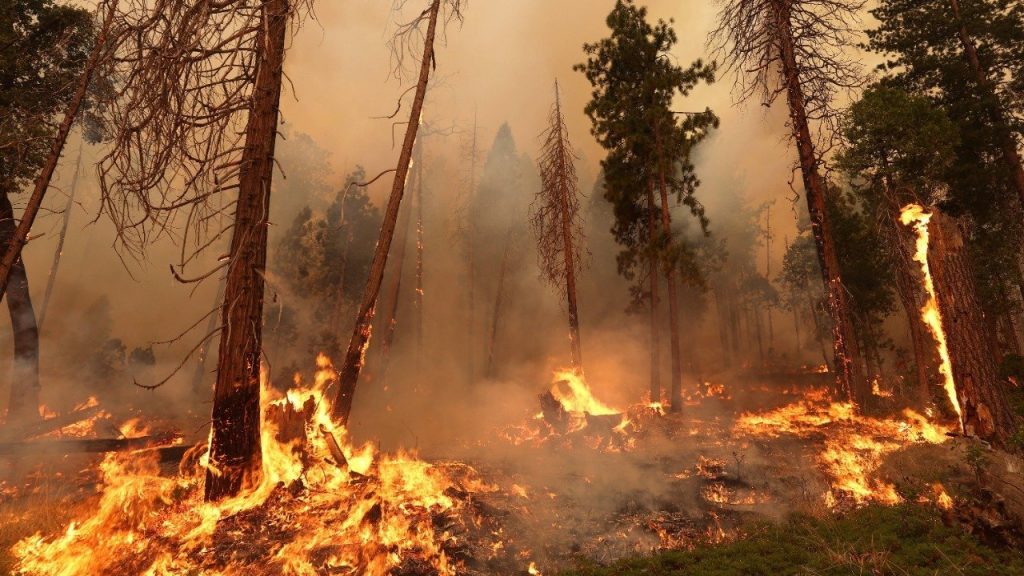A fierce California
wildfire expanded Sunday, burning several thousand acres and forcing
evacuations as tens of millions of Americans sweltered through scorching
heat.
More than 2,000 firefighters backed by 17 helicopters have been deployed
against the Oak Fire, which broke out Friday near Yosemite National Park, the
California Department of Forestry and Fire Protection (CAL FIRE) said in a
report.
But two days after it began, the blaze has already consumed more than 15,600
acres (6,313 hectares) and remains zero percent contained, the report said,
adding that heat combined with low humidity would “hamper” efforts Sunday.
“Extreme drought conditions have led to critical fuel moisture levels,”
according to CAL FIRE’s report.
Described as “explosive” by officials, the blaze has left ashes, gutted
vehicles and twisted remains of properties in its wake, as emergency
personnel worked to evacuate residents and protect structures in its path.
It has already destroyed 10 properties and damaged five others, with
thousands more threatened.
More than 6,000 people had been evacuated, said Hector Vasquez, a CAL FIRE
official.
“It was scary when we left because we were getting ashes on us, but we had
such a visual of this billowing. It just seemed like it was above our house
and coming our way really quickly,” one woman who had to be evacuated, Lynda
Reynolds-Brown, told local news station KCRA.
“We started getting our stuff together, and that’s when I went back up the
hill and looked and I’m like, ‘Oh my God.’ It was coming fast,” her husband
Aubrey Brown told the station.
California Governor Gavin Newsom on Saturday declared a state of emergency in
Mariposa County, citing “conditions of extreme peril to the safety of persons
and property.”
In recent years, California and other parts of the western United States have
been ravaged by huge and fast-moving wildfires, driven by years of drought
and a warming climate.
– Gore blasts ‘inaction’ –
Evidence of global warming could be seen elsewhere in the country, as 85
million Americans in more than a dozen states were under a weekend heat
advisory.
The crisis prompted former vice president Al Gore, a tireless climate
advocate, to issue stark warnings Sunday about “inaction” by US lawmakers.
Asked whether he believes US President Joe Biden should declare a climate
emergency, which would grant him additional policy powers, Gore was blunt.
“Mother Nature has already declared it a global emergency,” he told ABC News
talk show “This Week.”
And “it’s due to get much, much worse, and quickly,” he said separately on
NBC.
But he also suggested that recent crises, including deadly heat waves in
Europe, could serve as a wake-up call for members of US Congress who have so
far refused to embrace efforts to combat climate change.
“I think these extreme events that are getting steadily worse and more severe
are really beginning to change minds,” he said.
The central and northeast US regions have faced the brunt of the extreme
heat, which is forecast to lessen somewhat on Monday.
“Searing heat will continue across the Mid-Atlantic and Northeast tonight
before the upper trough over Canada dips down into the region to moderate
temperatures a bit tomorrow,” the National Weather Service said Sunday
afternoon.
But not all regions are expected to cool down: temperatures of 100 or more
degrees Fahrenheit (37 degrees Celsius) are forecast in the coming days
across parts of eastern Kansas and Oklahoma into southern Missouri and
northern Arkansas.
Not even the usually cool Pacific Northwest will escape the far-reaching
heat, with high temperatures “forecast to steadily rise over the next few
days, leading to the possibility for records to be broken,” the weather
service added.
Cities have been forced to open cooling stations and increase outreach to at-
risk communities such as the homeless and those without access to air
conditioning.
Various regions of the globe have been hit by extreme heat waves in recent
months, such as Western Europe in July and India in March to April, incidents
that scientists say are an unmistakable sign of a warming climate.BSS/AFP


